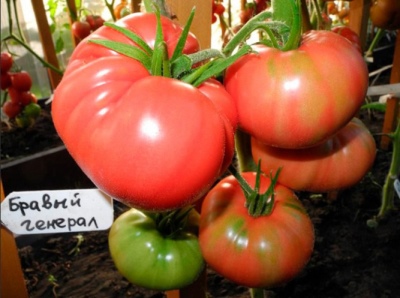
- Authors: Kotelnikova M. A., Antipova N. P. (Agrofirma "Altai Seeds" LLC)
- Year of approval: 2008
- Category: grade
- Growth type: indeterminate
- Appointment: fresh consumption, for juice
- Ripening period: early
- Ripening time, days: 100
- Growing conditions: for open ground
- Bush size: tall
- Bush height, cm: 150
Every gardener dreams of such a variety of tomatoes on the site that will give good yields, do not require specific care, easily withstand different climatic features and quickly adapt to the soil. These include the early tomato variety Brave General, which can grow in all regions of the country.
Breeding history
The tomato variety was bred thanks to the successful work of Altai breeders Antipova and Kotelnikova. In 2008, the species was entered into the state register and recommended for cultivation in all regions of Russia by planting in open ground or in greenhouses.
Description of the variety
Tomatoes Gallant General are tall, indeterminate bushes, reaching a height of 150 cm. The bushes are characterized by spreading, a moderate number of green leaves, a powerful stem and simple inflorescences, in which up to 3 fruits are formed. Due to the active growth and severity of the fruit, the bush needs a garter to support.
The main qualities of the fruit
The gallant general has impressive dimensions - the average weight of one tomato is 250 grams. The fruit has a flat-round shape with noticeable ribbing and a beautiful pink color that can approach raspberry. During the ripening period, the tomato has a green color with pronounced stripes. The skin is glossy and dense, due to which the integrity of the tomatoes is preserved during transportation and the duration of keeping quality.
Taste characteristics
Tomatoes are delicious, aromatic and juicy. The taste of tomatoes is sweet, with a subtle sourness, and the pulp is homogeneous, pale pink in color, with a small amount of seeds. 100 g of tomatoes contain 4.5% sugar. This type of tomato belongs to the category of universal, therefore it is eaten fresh, in the form of salads, as well as canned. Sauces, ketchups, juices are especially tasty.
Ripening and fruiting
The tomato is early, so it takes only 100 days to ripen (from the moment the first shoots appear until the tasting period). Fruiting in the variety is amicable, on each bush 5-10 fruits ripen at the same time. Despite the huge size of tomatoes, when fully ripe, they do not crumble from the bushes. Harvesting begins in the second half of July if the crop is grown outdoors, and a few weeks earlier if in a greenhouse.
Yield
The yield indicators of the variety are excellent. With proper care, about 4.4 kg of tomatoes can be harvested from 1 m2. In greenhouse conditions, yields are slightly higher.
The timing of planting seedlings and planting in the ground
Sowing seeds for seedlings is carried out in March. Soil for seeds is pre-disinfected using a solution of potassium permanganate and fertilized. After sowing, the seed boxes are placed in a warm room and wrapped in cellophane, which creates a greenhouse effect. A week later, when the first shoots appear, the polyethylene is removed, and the boxes are placed in a room with a temperature of 16-18 degrees.
This temperature will prevent over-stretching of the seedling bushes. Sufficient lighting is required to successfully grow seedlings, which can be provided with a phytolamp. As soon as 2-3 leaves appear on the bush, a pick will be needed. Seedlings grow in 60 days, and then they are planted in open ground.

Growing tomato seedlings is an extremely important process, because it largely depends on whether the gardener will be able to harvest at all. All aspects must be taken into account, from seedbed preparation to planting in the ground.
Landing scheme
It is recommended to plant seedlings in open ground when there is no scorching sun. On 1m2, you can place 4-5 copies. Correct fit - 50x70 centimeters.

Growing and care
Before planting seedling bushes, you need to prepare the soil: dig it up to improve air permeability, clean it of weeds and grass, fill it with mineral fertilizers. The plot must be sunny. The optimum temperature for the growth and development of culture is considered to be + 26-28 degrees, therefore, in case of excessive heat, it is recommended to build a canopy.
Tomatoes Gallant General need complex care: watering, feeding, furrowing the soil, weeding, garter and disease prevention.




A plant needs different micronutrients at each stage of growth. All fertilizers can be divided into two groups: mineral and organic. Folk remedies are often used: iodine, yeast, bird droppings, eggshells.
It is important to observe the rate and period of feeding. This also applies to folk remedies and organic fertilizers.
Disease and pest resistance
The culture has a high immunity to a number of viruses and diseases (powdery mildew, fusarium), however, preventive measures are still recommended, since it is easier to prevent a disease than to eliminate it.


Resistant to adverse weather conditions
The variety has a fairly high resistance to sharp temperature fluctuations.
Growing regions
Tomato grows in almost any region. In areas with warm and temperate climates, the crop is grown outdoors, and in the northern regions in greenhouses.
Review overview
Based on the numerous reviews, some conclusions can be drawn: tomatoes are unpretentious, quickly adapt to the climate and soil, and give abundant harvests. In addition, the variety is characterized by an unusually high taste. The only drawback that novice gardeners point out is some difficulty in growing seedlings: pulling it into growth.

























































































